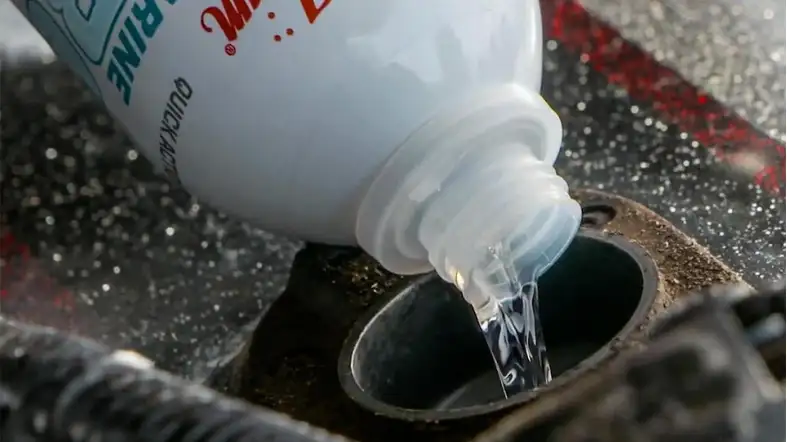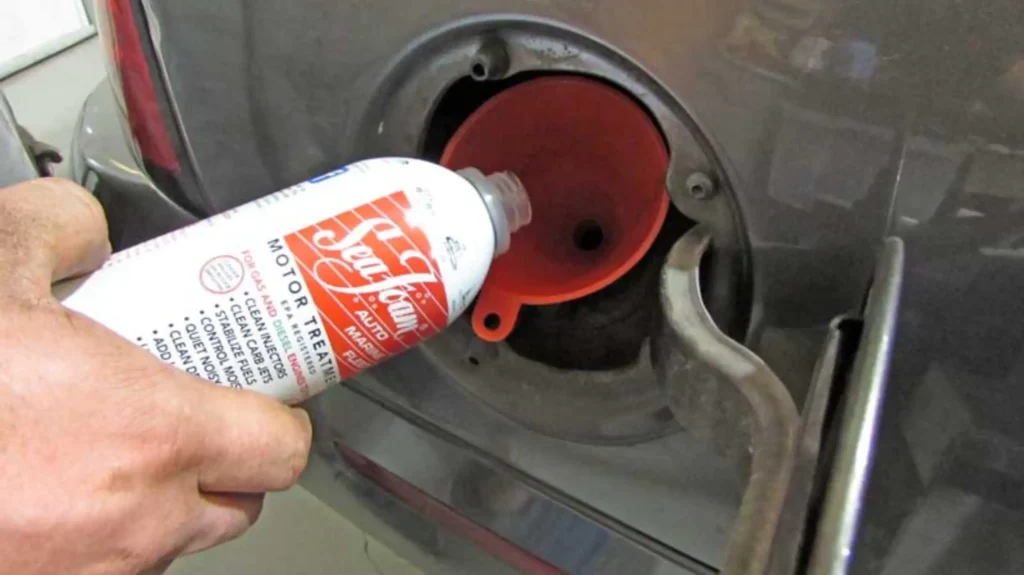Seafoam fuel additives have been used for decades to clean carburetors, fuel injectors, and intake valves.
But have you ever wondered if you can put Seafoam in your oil? Some claim it can improve engine performance and extend the life of your motor, while others caution against it.
In this post, we’ll explore the truth behind putting Seafoam in your oil and whether it’s a good idea for your vehicle.

Can You Put Seafoam In Your Oil?
Yes, Seafoam can be added to your oil as a way to clean and protect your engine. Adding too much Seafoam can cause damage to your engine, and it should never be used in place of regular engine oil changes.
It is also recommended to change your oil and filter shortly after adding Seafoam to your oil to ensure that any contaminants that the product has loosened are removed from the engine.
It is generally a good practice to use Seafoam as directed and in conjunction with regular maintenance to keep your engine running smoothly and efficiently.
Amount Of Seafoam To Add In Oil:
The amount of Seafoam to add to your oil depends on the size of your engine. As a general rule of thumb, you can add 1 ounce of Seafoam for every quart of oil capacity in your engine.
For example, if your engine holds 5 quarts of oil, you should add 5 ounces of Seafoam.
However, it’s always best to consult your owner’s manual or a mechanic for specific recommendations based on your vehicle’s make and model.
Overuse of Seafoam in your oil can cause damage to your engine, so be sure to follow the recommended guidelines.
How To Use Seafoam In Oil?
The following steps will guide you through the process of using seafoam in oil:
Determine the amount of Seafoam to use
According to most sources, you should add one ounce of Seafoam for every quart of oil in the crankcase.
For instance, if your engine requires five quarts of oil, you would need to add five ounces of Seafoam.
However, some sources suggest using 1 to 1.5 ounces of Seafoam per quart of motor oil.
Therefore, it’s always best to consult your owner’s manual or the Seafoam manufacturer’s recommendations for your specific engine.
Add Seafoam to your oil
Once you have determined the appropriate amount of Seafoam to use, remove the oil filler cap and pour the recommended amount of Seafoam directly into the engine crankcase.
It’s important not to exceed one treatment per oil change interval to avoid overusing the additive.
Drive your car for optimal benefits

To ensure optimal cleansing benefits, it’s recommended to drive your car for 100 to 300 miles before changing your oil and filter.
This allows Seafoam to work through the engine’s oil system and dissolve any deposits or contaminants.
Some sources, however, suggest adding Seafoam about 100 to 300 miles before changing the motor oil and filter.
Benefits of Using Seafoam in Your Oil

Here are some of the top advantages of using Seafoam in your oil:
Improved Engine Performance
One of the most significant benefits of adding Seafoam to your oil is improved engine performance.
Seafoam helps to remove engine deposits and carbon buildup, which can clog your engine and cause it to run less efficiently.
By cleaning out these deposits, Seafoam can help to improve fuel economy, power, and overall performance.
Increased Engine Lifespan
Another advantage of using Seafoam in your oil is increased engine lifespan.
Over time, engine deposits can cause wear and tear on your engine, leading to decreased lifespan and costly repairs.
By cleaning and lubricating your engine, Seafoam can help to reduce this wear and tear, extending the lifespan of your engine and saving you money in the long run.
Reduced Emissions
Seafoam can also help to reduce emissions from your vehicle. By cleaning out engine deposits,
Seafoam can help to improve the combustion process and reduce the amount of harmful emissions produced by your engine.
This can be especially beneficial for older vehicles that may have higher emissions levels.
Easy to Use
Using Seafoam in your oil is a simple and easy process.
Simply add the recommended amount of Seafoam to your engine oil before your next oil change, and let it work its magic.
Seafoam is safe for use with both conventional and synthetic oils, making it a versatile option for any vehicle.
Potential Risks and Drawbacks of Adding Seafoam to Your Engine Oil

Here are some potential risks and drawbacks of adding seafoam to your engine oil:
Engine Damage
One of the main concerns with using seafoam in your engine oil is the potential for engine damage.
The active ingredients in seafoam can break down the oil’s viscosity and cause the oil to become thinner.
This, in turn, can reduce the oil’s ability to protect the engine’s moving parts from wear and tear. Over time, this can lead to engine damage and failure.
Clogged Oil Filters
Another potential issue with using seafoam in your engine oil is the risk of clogged oil filters.
Seafoam can dislodge debris and contaminants in the engine, which can then become trapped in the oil filter. This can reduce oil flow and lead to engine damage or failure.
Warranty Issues
Using seafoam in your engine oil can also void your vehicle’s warranty.
Most car manufacturers recommend only using oil and oil additives that meet their specific requirements.
If you use an additive like seafoam that is not recommended by the manufacturer, you may be voiding your warranty and risking expensive repairs.
Environmental Concerns
Seafoam is a petroleum-based product, which means it can have negative environmental impacts.
When seafoam is burned in the engine, it can release harmful emissions into the air. Additionally, disposing of used seafoam can be difficult and may require special handling.
Seafoam in oil before and after
Here’s a table showing the comparison:
| Name | Before treatment | After treatment |
|---|---|---|
| Seafoam | Present | Absent |
| Oil | Contaminated | Cleaned |
Note: This assumes that the engine oil was contaminated with seafoam before treatment and that the seafoam was effectively removed by the Sea Foam additive, resulting in clean oil after treatment.
Can Seafoam thin out oil?
Seafoam is not designed to thin out oil, and there is no evidence to suggest that it does.
In fact, Seafoam is designed to dissolve and clean up any sludge, varnish, or carbon buildup that may be present in an engine.
Doing so, it can actually improve the oil’s viscosity and help it flow more freely through the engine.
This can result in better engine performance and increased fuel efficiency.
The Importance of Using the Right Amount of Seafoam
While Seafoam is a great product for cleaning and maintaining a car’s engine, it is essential to use it in the correct amount.
Adding too much Seafoam to the engine oil can cause it to become too thin, which can lead to decreased engine performance and potential engine damage.
Therefore, it is crucial to follow the manufacturer’s recommended usage instructions and not exceed the recommended amount.
FAQ
How Much Seafoam Should I Add To My Engine Oil?
The recommended amount of Seafoam to add to engine oil is 1 ounce per quart of oil.
It is important not to exceed this amount as too much Seafoam can thin out the oil and potentially damage the engine.
Can Seafoam Be Added To Synthetic Oil?
Yes, Seafoam can be added to both synthetic and conventional oil. It is safe to use in all types of engine oil.
How Often Should I Add Seafoam To My Engine Oil?
Seafoam can be added to the engine oil at every oil change as a preventive measure.
However, it is recommended to use Seafoam in moderation and not to overuse it.
Will Adding Seafoam To My Engine Oil Harm My Engine?
If used in the recommended amount, Seafoam will not harm your engine.
However, overuse can lead to oil thinning, which can cause engine damage.
How Long Should I Leave Seafoam In My Engine Oil?
Seafoam can be left in the engine oil for the entire oil change interval.
However, it is recommended to follow the manufacturer’s instructions for best results.
Can Seafoam Be Used In Diesel Engines?
Yes, Seafoam can be used in diesel engines. It is safe to use in both gasoline and diesel engines.
Will Seafoam Fix Engine Problems?
Seafoam can help to clean and maintain an engine, which can improve its performance.
However, it is not a guaranteed solution for all engine problems and should not be used as a substitute for proper maintenance or repair.
Conclusion
Adding Seafoam to your engine oil can be a great way to clean and protect your engine’s internal components.
It helps to break down harmful deposits and lubricate moving parts, ultimately extending the life of your engine.
Just remember to follow the manufacturer’s instructions carefully and only use the recommended amount of Seafoam.
With a little bit of care and attention, your engine can keep running smoothly for years to come
